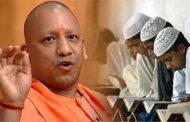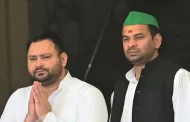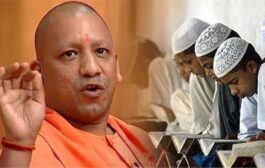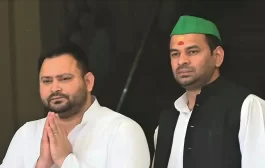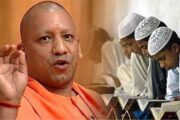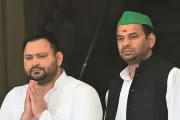Recently (May 2018) Hamid Ansari, the ex-Vice President of India, was invited to Aligarh Muslim University to honor him with life membership of AMU Students Union (AMUSU). He had due security with him, still the Hindu Yuva Vahini-ABVP activists could reach near his place of stay. The pretext of the armed protesters was that Jinnah’s portrait has been put up to please Ansari and that they will not allow Jinnah’s portrait in AMU. The usual violence followed few arrests of Vahini volunteers, most of them let off. This has been followed by series of statements from Yogi Adityanath, who incidentally is also the founder of this Hindutva group, saying that portrait will not be allowed, Subramaniam Swami questioned as to who will teach a lesson to AMU! The students of AMU are on the protest against the violence unleashed by Vahini and ABVP.
Too many angles to the story! First of all how come the armed volunteers of Vahini and ABVP reach near the place where Hamdi Ansari was put up? One recalls that every occasion there has been an attempt to humiliate this distinguished scholar, diplomat who held the high office. His photo of not saluting the Republic day parade, hinting he is disrespecting, was made viral only to bring in the realization that he was following the rule book as only President takes the salute and no one else. When he was given farewell Modi hinted at his being a Muslim, being attached to issues related to Muslims in a very humiliating way. In this light he being targeted is just the continuation of what RSS combine has been doing to Ansari so far.
How come someone recalled that Jiannh’s portrait is there and on that pretext the armed volunteers sneaked into AMU campus? Has the portrait been put up yesterday? The portrait has been there from 1938, as AMU students Union conferred a rare honor on him by giving him life membership of AMUSU. The statement is that Jinnah divided the country, so how can be we celebrate, him was the slogan. The role played by Jinnah in the freedom movement is not a linear one and is not uniform. He began as a part of the movement and was part of it in the beginning. He has to his credit being the Chairman of Reception committee which welcomed Gandhi on his return from South Africa. He was the one who fought the case, in which Bal Gangadhar Tilak was given the death sentence and it is due to his legal brilliance that he could save the life of Tilak. He was also the lawyer for the young revolutionary, Sardar Bhagat Singh and to cap it all he entered Hindu Muslim unity pact with Tilak (Lucknow, 1916). India’s nightingale Sarojini Naidu called Jinnah as the ‘ambassador of Hindu Muslim unity’.
There is another side to the story also. He dissociated from national movement once Gandhi launched the non cooperation movement in 1920, in which for the first time average people of the country were involved. This movement laid the foundation of the biggest ever mass movement in the history of the World. Jinnah was a constitutionalist and he felt involving average people in the struggle against British is unwarranted. Similarly he opposed Gandhi’s role in Khilafat movement and gradually dissociated from active involvement and left for London to practice law. The second major flaw which transformed Jinnah, who was basically secular, was his associating with and leading of Muslim League. Muslim League was given the status of being the representative of Muslims by British. This is a basically motivated exercise by British as Muslim League began from the Nawabs and Landlords, with feudal values inherent in it down to the core. His role as a leader of Muslim League and his Lahore resolution of separate country for Muslims, Pakistan, is what made him a communal leader. To blame him alone for partition of the country is a distorted presentation of history of modern India. The process of partition was begun by the British who pursued the policy of ‘divide and rule’. This was supplemented by communalists from both Hindu and Muslim. Savarkar was the first one to articulate that there are two nations in the country, the Hindu and the Muslim. As per this understanding the country belongs to Hindus so Muslim nation will have to remain subordinate to Hindus. This is where Jinnah falls in the communal trap and the logic he puts forward is, if there are two nations in the country, so why not two countries? So why not Pakistan?
Jinnah that way has been the subject of various biographies and interpretations. His August 11 1947 speech in Pakistan Constituent Assembly , stated that people are free to follow their own religion, state will not interfere in that, elaborates his secular values. Advani quite late in his life after having launched biggest attack on secular values by demolishing Babri Mosque; realized that Jinnah was secular. He called Jinnah Secular and paid with his career as RSS combine has built on the understanding of ‘Hate Jinnah’, have presented Jinnah as a symbol of Indian Muslims, Jinnah as a symbol of India’s enemy Pakistan!
With this AMU episode Hindu nationalist politics is killing many birds with a single stone. First, to target Hamid Ansari, whom they can’t approve of as his credential is thoroughly secular. Second is to create yet another divisive issue in the form of portrait of Jinnah, to add on to other emotive issues manufactured so far. And thirdly to intimidate the AMU campus in line with what has been done in JNU, Hyderabad universities to name the few.
One can say the Ghost of Jinnah, who can be called as ‘Secular soul in Communal body’ will keep visiting us, and RSS combine through its efforts will keep propping up divisive issues one after the other!
RAM PUNIYANI
Writer is a IIT Prof. and Involved with human rights and activities, communal harmony and initiatives to rising tide of fundamentalism in India.



